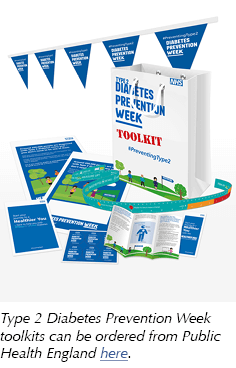This April saw the second NHS Type 2 Diabetes Prevention Week, which works to raise awareness of type 2 diabetes and how to prevent it. Nursing teams from across the NHS revel in a day out of the everyday working environment to promote ourselves and the work we do, and our team is no exception! We look forward to hanging out the bunting, blowing up some balloons, ironing our branded t-shirts, dusting off the not so “mobile” display boards, adorning the stickers and tweeting the associated hash tags (#PreventingType2).
As a team of diabetes specialists working within this area, we can never ignore the astounding figures that are highlighted day in and day out in the media about type 2 diabetes; there are an estimated 12.3 million people in England at high risk of developing the condition, with 3.8 million people diagnosed. It is a leading cause of preventable sight loss in people of working age and a major contributor to kidney failure, heart attack and stroke. This propels our enthusiasm for health education and promotion.
Our inpatient colleagues know all too well that one in six of all people in hospital have diabetes, and type 2 diabetes treatment accounts for costs of £8.8 billion a year to the NHS, not to mention the cost to the individuals. The number of people in Southampton with type 2 diabetes has reached 12 954, which is why, as a team, we were so keen to promote Type 2 Diabetes Prevention Week.
In the run-up to the week, we email the GP surgeries in our locality with a snapshot of the statistics and information on what they could do in house to promote the week. We include details of the Diabetes UK Know your risk website and a link to the Type 2 Diabetes Prevention Week website, where they can order a toolkit for use in their waiting rooms. We highlight some ideas on how they could promote awareness, such as running “at-risk clinics” and promoting the NHS Health Check for people over 40 years of age, and we also remind them of the ability to refer to the Healthier You: NHS Diabetes Prevention Programme, which is specifically for people with prediabetes or an HbA1c of 42–47 mmol/mol (6.0–6.4%).
In February this year, our community and inpatient teams in Southampton City, alongside the Diabetes and Research Wellness Foundation, worked together in a mass screening for type 2 diabetes of football fans attending the Southampton Football Club game against Cardiff at St Mary’s Stadium. The tests were anonymous and people were given letters for their GPs. We felt this would be an ideal population to catch as they often do not have time to attend healthcare services routinely for health screening. We carried out point-of-care HbA1c tests on football fans who were attending a local football match. The tests took 5 minutes to give a definitive answer, and during this time we had important discussions about the participants’ health. The population ranged from 18 to 93 years, including staff members from the stadium. Four people were found to have an HbA1c that required follow-up with their GP. However, everyone we spoke to came away knowing the differences between type 1 and 2 diabetes, as well the symptoms, and how to follow these up with their GP in future.
We really enjoy taking part in the campaign; it is a great way to raise awareness of type 2 diabetes and its prevention, and to promote the work we are doing locally to contribute. We are now looking at further events in the future.
Follow Beth on Twitter @SotonDSN





Study provides new clues to why this condition is more aggressive in young children.
14 Nov 2025